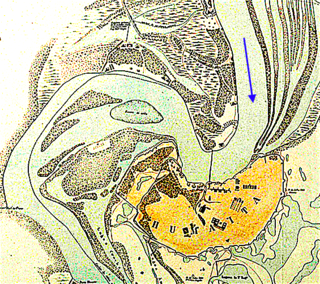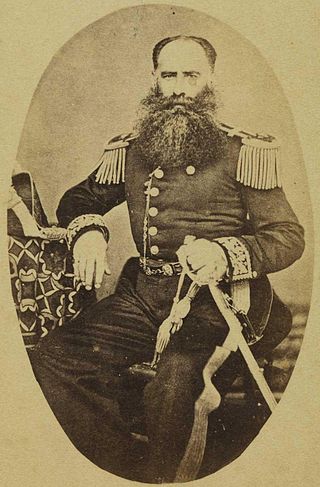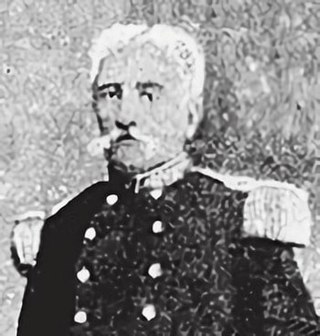
Francisco Solano López Carrillo was a Paraguayan military officer, politician and statesman who served as President of Paraguay between 1862 and 1870, of which he served mostly during the Paraguayan War (1864–1870). He succeeded his father Carlos Antonio López as the second president of Paraguay. He is the only Paraguayan president to have been killed in action. He is one of only two Paraguayans to have received the rank of Marshal, along with José Félix Estigarribia. He is officially recognized as the country's national hero since the presidency of Colonel Rafael Franco between 1936 and 1937 after decades of liberal governments that rejected his figure as heroic. The date of his birth, July 24, is officially recognized as the Paraguayan Army Day, while the date of his death, March 1, is officially recognized as the National Heroes' Day and is a national holiday in the country.

The Paraguayan War, also known as the War of the Triple Alliance, was a South American war that lasted from 1864 to 1870. It was fought between Paraguay and the Triple Alliance of Argentina, the Empire of Brazil, and Uruguay. It was the deadliest and bloodiest inter-state war in Latin American history. Paraguay sustained large casualties, but even the approximate numbers are disputed. Paraguay was forced to cede disputed territory to Argentina and Brazil. The war began in late 1864, as a result of a conflict between Paraguay and Brazil caused by the Uruguayan War. Argentina and Uruguay entered the war against Paraguay in 1865, and it then became known as the "War of the Triple Alliance."

The Battle of Curupayty was a key battle in the Paraguayan War. On the morning on 22 September 1866, the joint force of Brazilian, Argentine, and Uruguayan armies attacked Paraguayan fortified trenches on Curupayty. The Paraguayans were led by general José Eduvigis Díaz. This position was held by 5,000 men and 49 cannons, some of them in hidden places out of the attackers view. The Imperial Brazilian Navy gave support to the 20,000 assailants, but the ships had to keep some distance from the guns at the fortress of Humaitá, which led to the lack of accuracy and impact of the ship's fire. The navy's failure was crucial at the later ground battle result.

The Battle of Tuyutí was a Paraguayan offensive in the Paraguayan War targeting the Triple Alliance encampment of Tuyutí. It is considered to be the bloodiest battle ever in South America. The result of the battle was an Allied victory, which added to the Paraguayan troubles after the loss of its fleet in the Battle of Riachuelo.

The Treaty of the Triple Alliance was a treaty that allied the Empire of Brazil, Argentina, and Uruguay against Paraguay. Signed in 1865, after the outbreak of the Paraguayan War, its articles prescribed the allies' actions both during and after the war. An English translation of the text is reproduced in this article.

The military history of Brazil comprises centuries of armed actions in the territory encompassing modern Brazil, and the role of the Brazilian Armed Forces in conflicts and peacekeeping worldwide. For several hundreds of years, the area was the site of intertribal wars of indigenous peoples. Beginning in the 16th century, the arrival of Portuguese explorers led to conflicts with the indigenous peoples; a notable example being the revolt of the Tamoio Confederation. Sporadic revolts of African slaves also marked the colonial period, with a notable rebellion led by Zumbi dos Palmares. Conflicts were fought with other European nations as well – two notable examples being the France Antarctique affair, and a conflict with the Netherlands in the early 17th century over control of much of Northeastern Brazil. Although Portugal retained its possessions during conflicts with other nations, it lost control of the colony after the Brazilian war of Independence, which led to the establishment of the Empire of Brazil.

Manuel Luís Osório, Marquis of Erval was a Brazilian military officer, monarchist and politician. A member of the Imperial Army at the age of fifteen, he climbed all the posts of the military hierarchy of his time thanks to the soldier attributes that consecrated him as "The Legendary". He participated in the main military events of the late nineteenth century in the Río de la Plata region and is considered a hero of the Paraguayan War. He was declared patron of the Cavalry Branch of the Brazilian Army in 1962.

The Brazilian monitor Rio Grande was the second ship of the Pará-class river monitors built for the Imperial Brazilian Navy during the Paraguayan War in the late 1860s. Rio Grande participated in the Passage of Humaitá on 19 February 1868 and provided fire support for the army for the rest of the war. The ship was assigned to the Upper Uruguay flotilla after the war. Rio Grande was scrapped in 1907.

The Battle of Avay of 11 December 1868 was one of the last major combat engagements of the Paraguayan War, fought near the Avay stream in Paraguayan territory between the forces the Triple Alliance and the Paraguayan Army.

George Thompson (1839–1876) was a British engineer and military officer who was in charge of the Paraguayan military engineering during the Paraguayan War. He later wrote a history of this conflict that became one of the main sources on the subject.

The Fortress of Humaitá (1854–68), known metaphorically as the Gibraltar of South America, was a Paraguayan military installation near the mouth of the River Paraguay. A strategic site without equal in the region, "a fortress the likes of which had never been seen in South America", it was "the key to Paraguay and the upper rivers". It played a crucial role in the deadliest conflict in the continent's history – the Paraguayan War – of which it was the principal theatre of operations.

The Passage of Humaitá was an operation of riverine warfare during the Paraguayan War − the most lethal in South American history − in which a force of six Imperial Brazilian Navy armoured vessels was ordered to dash past under the guns of the Paraguayan fortress of Humaitá. Some competent neutral observers had considered that the feat was very nearly impossible.

The Battle of Itapirú took place during the Paraguayan War on April 17, 1866, after Brazil's capture of Purutué Bank a week earlier. The battle marked the beginning of the Triple Alliance's invasion of Paraguay.

The passage of Curupayty was an allied naval operation carried out on 15 August 1867, in the context of the Paraguayan War, which aimed to force the passage of Brazilian battleships against the defensive fortifications installed in the Curupayty fort on the banks of the Paraguay river. There was a second crossing on 13 February 1868 with a fleet of armored monitors destined to join the fleet that had crossed first to form the squadron responsible for forcing the Passage of Humaitá.

Vicente Barrios Bedoya was a Paraguayan general and politician who was the son-in-law of President Carlos Antonio López. Under López and his successor, Marshal and President Francisco Solano López, Barrios held many positions throughout the earlier years of the Paraguayan War and participated in the earlier battles and campaigns of the war.

The Humaitá campaign or the Cuadrilátero campaign was the third, longest and deadliest campaign of the Paraguayan War. The campaign lasted from 16 April 1866 to 5 August 1868. After the initial Paraguayan success in the Mato Grosso campaign and its failure in the Corrientes campaign, the armed forces of the Triple Alliance, Argentina, the Empire of Brazil and Uruguay, invaded the south of Paraguay. At a very short distance, they found the Paraguayan defensive device made up of four fortifications, the so-called "Cuadrilátero", which obstructed the passage to Asunción both by land and by the Paraguay River. A long series of battles cost huge numbers of casualties on both sides, with operations coming to a complete halt after the allied defeat at the Battle of Curupayty. Casualties on both sides were even higher from disease than from battle due to a cholera epidemic which was added to the appalling food and sanitary conditions.

The Brazilian ironclad Cabral was a Cabral-class armored corvette-type warship operated by the Imperial Brazilian Navy from 1866 to 1882. The vessel was built in the shipyard of the British company J. and G. Rennie in Greenwich, England, and was the leader of its class, which also included Colombo. It was launched in 1865 and incorporated into the navy on 15 September 1866. The battleship was entirely made of iron and displaced 858, 1,033 or 1,050 tons, depending on the source. It had two steam engines that developed up to 750 hp, propelling the vessel at about 20 km/h. Its structure comprised a double pillbox with eight gunports. The navy had great difficulties with this ship, which was hard to navigate and, due to the design of its casemate, which left a part of it unprotected, it was vulnerable to diving projectiles.

The assault on the battleship Barroso and the monitor Rio Grande, also known as assault on the battleships at Tagy, was a Paraguayan naval operation carried out during the Paraguayan War. The Imperial Brazilian Navy was present in the main actions of the allied forces. President Francisco Solano López knew of the threat that the navy posed and wanted to capture some of its ships, the ironclads. The seizure was also seen as a form of compensation for the losses incurred as a result of the war. Assault plans were created and executed in 1868.

José María Bruguez (1827-1868) was a Paraguayan general during the Paraguayan War. He was one of the most prominent Paraguayan generals of the war, being known for his artillery services during naval engagements of the war. He died during the 1868 San Fernando massacre after President Francisco Solano López accused Bruguez of conspiring against him.

Domingo Antonio Ortiz was a Paraguayan naval officer and politician. He served with distinction in the Triple Alliance War, and after the conflict participated in various governments through the 1870s and 1880s.


















